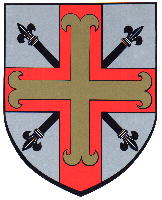Waldbredimus: Difference between revisions
Knorrepoes (talk | contribs) m (Text replace - "'''Origin/meaning :'''<br/>" to "====Origin/meaning====") |
Knorrepoes (talk | contribs) m (Text replace - "[[Literature" to "{{media}} [[Literature") |
||
| Line 16: | Line 16: | ||
In the arms the lily cross is taken from the arms of the Wiltheim family and the four points also represent the four abbeys. | In the arms the lily cross is taken from the arms of the Wiltheim family and the four points also represent the four abbeys. | ||
{{media}} | |||
[[Literature]] : Loutsch, J-C. et al.; Armorial communal du Grand-Duché de Luxembourg, Fisch, Luxembourg, 1989, 331 p. | [[Literature]] : Loutsch, J-C. et al.; Armorial communal du Grand-Duché de Luxembourg, Fisch, Luxembourg, 1989, 331 p. | ||
Revision as of 08:46, 9 July 2014
| Heraldry of the World Civic heraldry of Luxembourg |
WALDBREDIMUS
Origin/meaning
The arms were granted on March 2, 1982.
The arms are a combination of the arms of the Lords of Pittange (cross) and the Wiltheim family (sticks). Waldbredimus was a joined possession of 4 abbeys in the Middle Ages; St. Maximin de Treves, Marienthal, Munster and Bonnevoie. The local government was carried out by the Lords of Pittange. In the 16th century the Wiltheim family acquired the area from the abbeys and made it a separate Lordship.
In the arms the lily cross is taken from the arms of the Wiltheim family and the four points also represent the four abbeys.
Contact and Support
Partners:
Your logo here ?
Contact us
© since 1995, Heraldry of the World, Ralf Hartemink 
Index of the site
Literature : Loutsch, J-C. et al.; Armorial communal du Grand-Duché de Luxembourg, Fisch, Luxembourg, 1989, 331 p.











